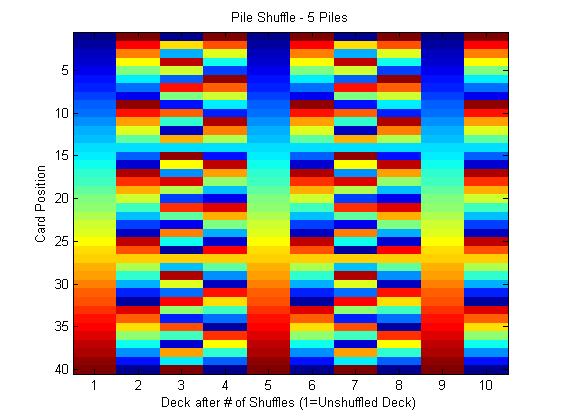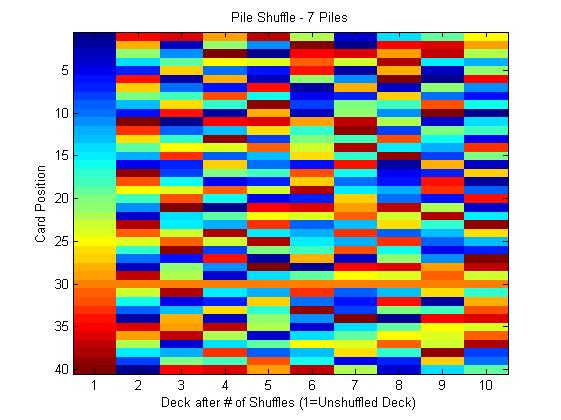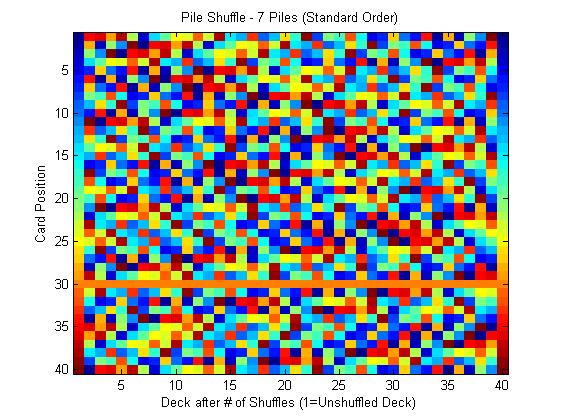Every Day I’m Shuffling

Shuffling is a core element of a card game and getting your deck sufficiently randomised has been a point of discussion cards were first shuffled. This article is actually a re-post with permission of one which originally appeared on the Dojo of Lies website. In it, Rory Heffernan goes into some great detail and visualises the randomisation of the different types of shuffle.
Forward
This article analyses shuffling techniques and estimates deck order after shuffling. If, after shuffling a deck, you know the location (accurately or otherwise) of any card or card type in a deck (yours or your opponent’s), it is your duty as a player to reshuffle or ask your opponent to reshuffle the deck as that knowledge is cheating. All estimates here are for example purposes only.
Every Day I’m Shuffling
A lot of time and effort is put in by deck builders to determine the probability of drawing a certain card over the course of a game or at a specific time: Whether it’s the number of holdings, the amount of ‘meta cards’, or simply whether having two or three of a certain card is better in the deck.
And yet, after all this effort is put in, many players still complain that they can go an entire tournament without seeing a certain card. We need to realise that if there isn’t an equal chance of seeing each card in your deck, mental calculations of probability in a game situation are completely invalid, often hindering your ability to make decisions.
A random deck is very important, and yet many players don’t put enough thought into their shuffle. Most don’t understand the reasoning behind all the shuffles they use; I know I certainly didn’t before researching this article. In a world where poker and M:tG are so popular it is surprising to see that there is actually very little information available on deck randomisation.
The little information that is available to us comes from the world of card magic where the shuffler’s objective is actually to force cards to certain positions, completely the opposite of our interests.
In this article we will look at shuffling in the hopes to find a quick, simple means of randomizing a forty card deck so that each card has an equal chance of being in any position in the deck.
Firstly, let’s look at four of the most popular shuffles and the ways in which they influence the ordering of the deck.
The Hindu Shuffle
Placing the deck on its side in your left hand, pick up the bottom 2/3’s of the deck with the thumb and middle finger of your right hand. By transferring chunks of cards from the top of your right hand’s pile to the front of the pile in your left hand you create the new reordered deck.
The Hindu shuffle is seen as a beginner’s shuffle in many card circles as it is relatively fast and very easy to do and it is simple to teach to children. A variation of it is used a lot in card magic as it is very easy to fool the eye with. It also has an upside for trading card games in that it has minimal impact on valuable cards.

A quick analysis of the capability of a shuffle can be done by looking at the way in which it affects the top card, the bottom card and a clump of cards in the middle. Here is an estimate of the effects of continuous Hindu shuffling on a 40 cards deck.
Here the top card of the original deck is shown in dark blue and the bottom card in dark red. The clump of cards in the middle is shown in a yellow to orange spectrum.
The first column is the initial deck order and the subsequent columns are deck orderings after hindu shuffles.
This estimation shows that this shuffle is not particularly effective. The top and bottom cards are alternating between the top and bottom sections of the deck. The clump on the other hand is not separating much at all. If this clump represented your holdings, for example, a simple cut of the deck after most of these shuffles could leave you at a huge disadvantage.
The biggest danger in this shuffle takes place after the 6th shuffle (column 7) where the deck reverts almost perfectly to its starting order. There’s a reason this shuffle is liked by card magicians, frankly they can keep it. This shuffle is not suited for competitive card games.
The Riffle Shuffle
The deck is cut into two equal piles. Taking a pile in each hand, place your thumbs on the inside edges, and middle to little fingers on the outside edges of the piles. The index finger of each hand is placed at the centre of top cards’ backs helping to bend the inside edges of the piles upward. The two piles are then slowly released so as to allow the cards to alternately fall interweaving between the two piles. The piles are then compressed to come together forming a complete deck.
This is a very popular shuffle among card professionals as it’s quite easy to learn and yet quite hard to master. It’s not as popular in trading card games, where the cards are particularly valuable, as it can have a warping effect on cards. As L5R cards aren’t as valuable as other card games it is seen as a perfectly acceptable shuffle to do on your own deck while still being seen as a little disrespectful to do on an opponent’s without consent.
Oh, and most importantly if done quickly and evenly it looks damn impressive.

This shuffle, which many players (myself included), do on a daily basis is actually not very good at all. There’s pretty good clump spreading capabilities for 4-6 riffles but eventually it causes the deck to perfectly reform into its initial order, Le Gasp! The top and bottom card don’t move at all.

A larger scale analysis actually shows that no matter how many times you Riffle shuffle, cards from the top will remain closer to the top, while cards from the bottom will tend more towards the bottom.
Damaging cards and not randomising the deck well. If this didn’t look so damn pretty I’d chalk it up as strike two.
The Sleeved Slide Shuffle
Starting as with the Hindu shuffle, place the deck on its side in your left hand. Picking up the bottom half of the deck in your right hand, tilt it slightly and gently force it into the deck in your left hand. The bottom corners of the sleeves in your right hand should interweave themselves between the sleeves of the cards in your left hand allowing them to slide together. The cards are realigned to form a reordered deck.

This is a shuffle that has developed for sleeved card games. The effect is much like that of a Riffle shuffle in that it alternates cards from the top and bottom of the pre-shuffled deck, but alleviates the need to bend the cards. As it has a variable overlap (some cards don’t get interwoven) we can treat it separately to the Riffle Shuffle.
Much like the Riffle shuffle it imitates, this shuffle provides adequate randomness and clump spread with 4-6 consecutive shuffles but after that it shows its true heinous trend.
10 consecutive shuffles in this manner can actually reverse the order of the deck (This is greatly dependent on the amount of overlap).
This should be a big eye-opener for those of you who think it is ok to do this shuffle a lot.
The Pile “Shuffle”
Cards are taken one at a time from the top of the deck and stacked sequentially in piles. Once all cards in the deck have been piled, the piles are collected and placed on top of each other to reform a reordered deck.
There is an element to our game that I have neglected to touch on so far. Sleeves, once they have been in use for a long period of time, gain a layer of oil on them which causes them to like to stick together. This stickiness forms clumps that can remain despite the above traditional shuffling. This leads to a lot of problems in deck randomization and is a reason we should take all of my images so far with a pinch of salt. Once again, they are purely meant as estimates of trends, not to determine the exact position of cards after a shuffle. (see Forward)
The Pile shuffle is used to counteract the effects of this card stickiness. By moving each card away from any it may have become stuck to we achieve a much greater separation of clumps. There is however a major downside.
This is not shuffling. If at any point after a shuffle you know the location of any specific card, you have not shuffled. The very way in which we pile shuffle is completely against the idea of the randomization of cards. It can only, therefore be considered shuffling when combined with other shuffles.
So how many piles do we use? Here are some examples of pile shuffles with different numbers of piles. This time we’ll look at the complete deck spectrum.



Four and five Piles each yield a standard pile separation after one shuffle but if you do multiple pile shuffles you very quickly put yourself at risk of reforming your original deck. The top and bottom cards also tend to just switch positions.
After looking through the various pile numbers, seven piles seem to be the optimum for a 40-card deck. It is also widely considered as the best number for a 60 card Magic deck. It’s worth noting that if you’re up to 42 cards, use 5 piles instead.
Achieving Pure Randomness
So we’ve learned from the above that no single shuffle will properly randomise your deck. A proper shuffling technique will therefore have to mix a pile shuffle (to remove stick and to separate clumps) with a traditional shuffle (to randomise the ordering of the cards).
Philosophically speaking, pure randomness is something that may not actually be possible. On some level, it can be argued, there is cause to all effect. For our purposes we’ll be satisfied with just an even chance of seeing any single card anywhere in the deck for any number of repetitions of a shuffle sequence.
To achieve this we will need to harness Elements of Randomness.

The first such element I’m going to suggest is the use of random pile ordering. This means that instead of a traditional pile shuffle, where the cards are laid on the piles in order (1,2,3,4,5,6,7,1,2,3… etc.) and the piles collected in this same order, that the cards be laid in piles at random and that the piles are collected at random. This changes our estimation of the pile shuffle.

Notice how we have removed the pattern from the shuffle. The deck no longer resets and the 30th card which was not moving is now free to move around the deck. This now looks very close to a perfect random deck.
Unfortunately, a pile shuffle takes about 20 seconds to do and doing it enough times to reach a suitable level of randomness would probably start bordering on stalling. To speed this process up we can combine the random Pile shuffle with the Sleeve Slide shuffle from before.
The Element of Randomness we can add into the slide shuffle is the overlap. If we vary the overlap as we shuffle we can maximise the power of this shuffle.
Here is an estimation of randomness in which each subsequent column is after 4 slide shuffles with varying overlap and a single random pile shuffle.

There may not be such thing as ‘pure randomness’, but this to me is pretty damn close.
Recap
- A Hindu Shuffle should not be used for L5R
- A Riffle Shuffle is nice for flare but not great for deck randomizing.
- Don’t trust people who don’t mix their shuffles
- Pile Shuffle a 40-card deck with 7 piles and mix it with traditional shuffles.
- A Pile shuffle should be done every 4 or 5 Slide shuffles
- Always cut your opponents decks. If their deck is random you’ve made no difference.
That’s it for now. If you use a shuffle I didn’t mention here or you have any comments, questions or opinions I’m very eager to hear them on the forum. Who knows what the next Mental Meta will be, maybe I’ll actually get around to finishing behaviourism….
Rory
If you have any comments or feedback please post them in the comments section below. Check us out on the Imperial Advisor website, podcast, and YouTube channel for more discussion about the L5R LCG.

5 Replies to “Every Day I’m Shuffling”
Curious, is there a better way to cut decks as well? If the decks are random, you don’t change anything. But if the deck isn’t what’s the best strategy? I assume most players wrongly shuffle their decks unwittingly. But if one would try to gain advantage / cheat from deck cutting, it would be to place best cards on bottom half, since most people roughly cut mid-deck?
Some players do a 3 part cut, rearranging those parts. So the either the bottom third or the middle third will end up on the top.
Some players will give their opponent’s deck a quick shuffle. I’ve heard of (but never saw) players objecting to this as they don’t like someone else shuffling their deck their deck. So you should be respectful of others belongings. If there is some concern, you can always ask a judge over to shuffle as personally I’d have concerns about a player unwilling to have their deck shuffled.
Your opponent might object and say that you can only cut, but the rules are pretty clear. From the L5R Tournament Regulations:
“Each player shuffles their dynasty and conflict decks thoroughly and presents each of them to his or her opponent. The opponent may shuffle and cut each deck if desired. After the opponent has had a chance to shuffle the deck, each player places their dynasty deck to the left of their play area and their conflict deck to the right.”
So you can choose to shuffle if you wish and it might be a good habit to get in.
I’d recommend this video on the topic of shuffling: https://www.youtube.com/watch?v=AxJubaijQbI
The article seems to have some misconceptions about especially the riffle shuffle.
It’s a good video, but I’m afraid I have to disagree with its assertion that 7 riffle shuffles will be enough. As comments on the video point out, and Rory had visually demonstrated above, perfectly done riffle shuffles have their own order and eventually return to the original state. I believe the video assumes the riffle shuffles will be done ‘imperfectly’ and it bases randomness on the distance a card will travel during the process. Card games aren’t about guessing individual cards however and getting a nice spread of card types is a great way to cheat.
Worst case scenario, your opponent is making sure the top cards of the riffle never change getting them the perfect start!
Sure, you’re assuming no malicious intent and that you do “imperfect” riffle shuffle. I thought the point of this article was discussing how to get a properly randomized deck through shuffling?
The thing you’re talking about is just a more convenient way to talk about what a properly randomized deck is, rather than saying that all configurations are equally likely after a proper shuffle.
When you do a riffle shuffle with the intent to properly randomize the deck the assumptions in the linked video are not too unrealistic. If you do a riffle shuffle with the intent of cheating then sure, no amount of riffle shuffle will ever be enough.